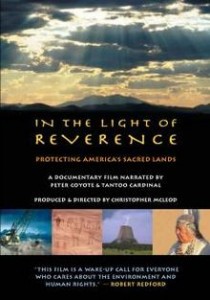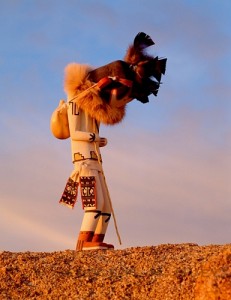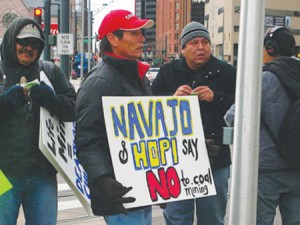Hopi and Japanese: Water has intelligence
Japanese and Hopi gathered on Hopiland to share this truth in 2004: Water has intelligence and responds to positive and negative words. It is republished now, following the tsunami and nuclear disaster in Japan.
Water is alive
Article by Brenda Norrell
Photo: Water crystal responding to positive words.
On Hopiland in 2004, Vernon Masayesva, executive director of Black Mesa Trust, and researcher Dr. Masaru Emoto, chief of the Hado Institute in Tokyo, spoke at the Hopi Veterans Center and revealed the secrets and science of the intelligence of water.
During the Hisot Navoti (knowledge of ancestors) Masayesva showed amazing film footage, revealing startling transformations in water crystals when exposed to music and written words. Emoto’s photographs reveal water crystals, under high magnification, have drastically different forms from different water sources. Further, Emoto shows that water changes its expression as a result of human actions.
When water is exposed to the music of Mozart and Beethoven, crystals expand and become more beautiful. These crystals resemble diamonds, with flower buds blossoming on their points, as the music plays. Emoto explains that water carries and responds to the vibrations of music. He reveals even more amazing research, showing water responds to the written word.
When clear tubes of water are placed over positive and negative words, the structure of water crystals change. Water crystals increase in beauty when placed over the word “peace,” but are transformed to dark and ugly crystals when placed over the word “war.”
When water is placed over the word “let’s,” the crystals expand and increase in beauty. However, when water is placed over the word “must,” the crystals become ugly with a dark green center. Emoto says water is letting us realize the hidden power of words.
During the gathering for the defense of pure water, Jerry Honawa, Hopi elder, said, “Water has intelligence.”
Masayesva said, “If you are happy, you will have happy crystals; if you are angry, you will have angry crystals.” Masayesva also shared the history of the Hopi people, revealing their destiny intertwined with the earth and its mysteries.
“According to Hopi, long ago there was nothing but water from the beginning of time. This is what we call the First World of Hopi. “Life was created from water, from the land, from the sun.” When life was first created, it was beautiful, a perfect circle. On Hopiland today there are areas of perfect seashells, proof that this land was once underwater as Hopi are told. There are perfect fossils here, he said.
“Where does coal come from? It comes from plants. Everywhere you go, you see dinosaur tracks. This must have been a beautiful place at one time.”
In the First World, there was balance, harmony and peace. This balance and harmony, however, was destroyed in the Third World because of man and his greed. The ancestors began searching for a safe place to begin a new life. Bird was sent out and returned with news of this place.
“Through the bamboo, they entered the new land,” Masayesva said. “It is a metaphor, we don’t really know, but we came from somewhere where there was bamboo.” When the people arrived in this new land, they thought they had left evil behind them. But after a child died, they realized that evil had come with them. Those with the two hearts had come. “Evil is necessary to understand what good truly is,” Masayesva said.
The people knew they had to learn from the destruction of the Third World and not return to those ways. They wanted to create a new way of life. The Hopi people were not led by politicians, they were led by priests, often the poorest man in the village who denied himself everything for the benefit of his children.
In this new place they found a man who grew beautiful corn. It was Ma’sau, guardian of the land. Ma’sau said it is a harsh land, but if the people were willing to live Ma’sau’s way of life, they could stay here.
Ma’sau told the people, “If you follow this way of life, you can stay here forever.” Ma’sau showed the people corn, a gourd of water and planting stick. “He said if you decide to stay here you must help me take care of this land, then you can stay.”
Ma’sau told them that others are coming. “They will claim everything when they come, even the oceans, the air and the stars.” Ma’sau told the Hopi people to migrate to the four corners of the world, then return here to Black Mesa. The gourd to carry water was also a revelation, showing that water here is not infinite, it is limited.
Masayesva said the colors of the corn represent the colors of all mankind, yellow, purple, red and white. The sweet corn also represents the ancestors and the purple the heavens. Corn, too, gave Hopi a new way of life, and meant that the people no longer had to search for food every day, leaving them free for other things.
The planting stick represents tools or technology, which can be used for good or for destruction. There was a time when smallpox nearly eliminated the Hopi people, with only 300 Hopi surviving, Masayesva said technology can prevent and cure illness today, but it threatens to end humankind with the production of nuclear bombs. Nuclear power and travel to distant planets have resulted in dangerous “god-like powers.”
The waters–aquifers, springs, lakes, rivers, oceans and glaciers– work in harmony to sustain life. Hopi believe the aquifers breathe, breathe in rain and snow and breathe it out. The springs are the breathing holes. Humankind is a participant in water-life; mankind’s thoughts influence whether the rain and snow comes.
Of the world’s water today, Masayesva said 97 percent is seawater and 2 percent is bound in glaciers. Only1 percent is available for drinking.
However, America is a nation of waste. “We are a throwaway society. We think we are never going to run out of anything.”
Masayesva said the people must honor their trust as guardians of the water and land.
“If we don’t, we will break the circle.”





